Intercomparisons of Three Gauge-Based Precipitation Datasets over South America during the 1901–2015 Period
Abstract
1. Introduction
2. Materials and Methods
2.1. Study Area
2.2. Data Description
2.3. Methods
2.3.1. Analyses for Individual Dataset
2.3.2. Intercomparisons among Datasets
3. Results
3.1. Comparisons between the T-Period (1901–2015) and the Subperiods of the Mean and Variance of the Annual PRP
3.1.1. GPCC
3.1.2. UDEL
3.1.3. CRU
3.1.4. Analyses of Specific Areas
3.2. Comparisons among the Datasets
3.2.1. Annual Cycle
3.2.2. Statistical Indicators
4. Discussion
5. Conclusions
Author Contributions
Funding
Institutional Review Board Statement
Informed Consent Statement
Data Availability Statement
Acknowledgments
Conflicts of Interest
References
- Trenberth, K.E.; Dai, A.; Rasmussen, R.M.; Parsons, D.B. The Changing Character of Precipitation. Bull. Am. Meteorol. Soc. 2003, 84, 1205–1217+1161. [Google Scholar] [CrossRef]
- Kidd, C.; Huffman, G. Global Precipitation Measurement. Meteorol. Appl. 2011, 18, 334–353. [Google Scholar] [CrossRef]
- Mesa-Sánchez, Ó.J.; Peñaranda-Vélez, V.M. Complejidad de La Estructura Espacio-Temporal de La Precipitación. Rev. Acad. Colomb. Cienc. Exactas Físicas Nat. 2015, 39, 304–320. [Google Scholar] [CrossRef]
- Chou, C.; Neelin, J.D. Mechanisms of Global Warming Impacts on Robustness of Tropical Precipitation Asymmetry. J. Clim. 2004, 17, 2688–2701. [Google Scholar] [CrossRef]
- Seneviratne, S.I.; Zhang, X.; Adnan, M.; Badi, W.; Dereczynski, C.; Di Luca, A.; Ghosh, S.; Iskandar, I.; Kossin, J.; Lewis, S.; et al. Chapter 11: Weather and Climate Extreme Events in a Changing Climate. In Climate Change 2021: The Physical Science Basis. Contribution of Working Group I to the Sixth Assessment Report of the Intergovernmental Panel on Climate Change; Masson-Delmotte, V., Zhai, P., Pirani, A., Connors, S.L., Péan, C., Berger, S., Caud, N., Chen, Y., Goldfarb, L., Gomis, M.I., et al., Eds.; Cambridge University Press: Cambridge, UK, 2021; p. 345. [Google Scholar]
- Sun, Q.; Miao, C.; Duan, Q.; Ashouri, H.; Sorooshian, S.; Hsu, K.L. A Review of Global Precipitation Data Sets: Data Sources, Estimation, and Intercomparisons. Rev. Geophys. 2018, 56, 79–107. [Google Scholar] [CrossRef]
- Carvalho, L.M.V. Assessing Precipitation Trends in the Americas with Historical Data: A Review. Wiley Interdiscip. Rev. Clim. Chang. 2020, 11, e627. [Google Scholar] [CrossRef]
- Gehne, M.; Hamill, T.M.; Kiladis, G.N.; Trenberth, K.E. Comparison of Global Precipitation Estimates across a Range of Temporal and Spatial Scales. J. Clim. 2016, 29, 7773–7795. [Google Scholar] [CrossRef]
- Costa, M.H.; Foley, J.A. A Comparison of Precipitation Datasets for the Amazon Basin. Geophys. Res. Lett. 1998, 25, 155–158. [Google Scholar] [CrossRef]
- Negrón Juárez, R.I.; Li, W.; Fernandes, K.; de Oliveira Cardoso, A. Comparison of Precipitation Data Sets over the Tropical South American and African Continents. J. Hydrometeorol. 2009, 10, 289–299. [Google Scholar] [CrossRef]
- Gulizia, C.; Camilloni, I. A Spatio-Temporal Comparative Study of the Representation of Precipitation over South America Derived by Three Gridded Data Sets. Int. J. Climatol. 2016, 36, 1549–1559. [Google Scholar] [CrossRef]
- Shimizu, M.H.; Anochi, J.A.; Kayano, M.T. Precipitation Patterns over Northern Brazil Basins: Climatology, Trends, and Associated Mechanisms. Theor. Appl. Climatol. 2022, 147, 767–783. [Google Scholar] [CrossRef]
- Schneider, U.; Becker, A.; Finger, P.; Meyer-Christoffer, A.; Ziese, M.; Rudolf, B. GPCC’s New Land Surface Precipitation Climatology Based on Quality-Controlled in Situ Data and Its Role in Quantifying the Global Water Cycle. Theor. Appl. Climatol. 2014, 115, 15–40. [Google Scholar] [CrossRef]
- Harris, I.; Jones, P.D.; Osborn, T.J.; Lister, D.H. Updated High-Resolution Grids of Monthly Climatic Observations—The CRU TS3.10 Dataset. Int. J. Climatol. 2014, 34, 623–642. [Google Scholar] [CrossRef]
- Willmott, C.J.; Matsuura, K. Global (Land) Precipitation and Temperature; Center for Climatic Research, Department of Geography, University of Delaware: Newark, NJ, USA, 2023; Available online: https://climatedataguide.ucar.edu/climate-data/global-land-precipitation-and-temperature-willmott-matsuura-university-delaware (accessed on 19 February 2024).
- Marengo, J.A. Interdecadal Variability and Trends of Rainfall across the Amazon Basin. Theor. Appl. Climatol. 2004, 78, 79–96. [Google Scholar] [CrossRef]
- Andreoli, R.V.; Kayano, M.T. ENSO-Related Rainfall Anomalies in South America and Associated Circulation Features during Warm and Cold Pacific Decadal Oscillation Regimes. Int. J. Climatol. 2005, 25, 2017–2030. [Google Scholar] [CrossRef]
- Kayano, M.T.; Andreoli, R.V. Relations of South American Summer Rainfall Interannual Variations with the Pacific Decadal Oscillation. Int. J. Climatol. 2007, 27, 531–540. [Google Scholar] [CrossRef]
- Jury, M.R. An Interdecadal American Rainfall Mode. J. Geophys. Res. Atmos. 2009, 114, 1–11. [Google Scholar] [CrossRef]
- Kayano, M.T.; Capistrano, V.B. How the Atlantic Multidecadal Oscillation (AMO) Modifies the ENSO Influence on the South American Rainfall. Int. J. Climatol. 2014, 34, 162–178. [Google Scholar] [CrossRef]
- Dong, B.; Dai, A. The Influence of the Interdecadal Pacific Oscillation on Temperature and Precipitation over the Globe. Clim. Dyn. 2015, 45, 2667–2681. [Google Scholar] [CrossRef]
- Kayano, M.T.; Andreoli, R.V.; Souza, R.A.F. El Niño–Southern Oscillation Related Teleconnections over South America under Distinct Atlantic Multidecadal Oscillation and Pacific Interdecadal Oscillation Backgrounds: La Niña. Int. J. Climatol. 2019, 39, 1359–1372. [Google Scholar] [CrossRef]
- Kayano, M.T.; Andreoli, R.V.; Souza, R.A.F. Pacific and Atlantic Multidecadal Variability Relations to the El Niño Events and Their Effects on the South American Rainfall. Int. J. Climatol. 2020, 40, 2183–2200. [Google Scholar] [CrossRef]
- He, Z.; Dai, A.; Vuille, M. The Joint Impacts of Atlantic and Pacific Multidecadal Variability on South American Precipitation and Temperature. J. Clim. 2021, 34, 7959–7981. [Google Scholar] [CrossRef]
- Prado, L.F.; Wainer, I.; Yokoyama, E.; Khodri, M.; Garnier, J. Changes in Summer Precipitation Variability in Central Brazil over the Past Eight Decades. Int. J. Climatol. 2021, 41, 4171–4186. [Google Scholar] [CrossRef]
- Kamae, Y.; Li, X.; Xie, S.P.; Ueda, H. Atlantic Effects on Recent Decadal Trends in Global Monsoon. Clim. Dyn. 2017, 49, 3443–3455. [Google Scholar] [CrossRef]
- Garreaud, R.D.; Vuille, M.; Compagnucci, R.; Marengo, J. Present-Day South American Climate. Palaeogeogr. Palaeoclimatol. Palaeoecol. 2009, 281, 180–195. [Google Scholar] [CrossRef]
- de Barros Soares, D.; Lee, H.; Loikith, P.C.; Barkhordarian, A.; Mechoso, C.R. Can Significant Trends Be Detected in Surface Air Temperature and Precipitation over South America in Recent Decades? Int. J. Climatol. 2017, 37, 1483–1493. [Google Scholar] [CrossRef]
- Flantua, S.G.A.; Hooghiemstra, H.; Vuille, M.; Behling, H.; Carson, J.F.; Gosling, W.D.; Hoyos, I.; Ledru, M.P.; Montoya, E.; Mayle, F.; et al. Climate Variability and Human Impact in South America during the Last 2000 Years: Synthesis and Perspectives from Pollen Records. Clim. Past 2016, 12, 483–523. [Google Scholar] [CrossRef]
- Shepard, D. Two- Dimensional Interpolation Function for Irregularly- Spaced Data. In Proceedings of the 23rd ACM National Conference, New York, NY, USA, 27–29 August 1968; pp. 517–524. [Google Scholar] [CrossRef]
- Willmott, C.J.; Rowe, C.M.; Philpot, W.D. Small-Scale Climate Maps: A Sensitivity Analysis of Some Common Assumptions Associated with Grid-Point Interpolation and Contouring. Am. Cartogr. 1985, 12, 5–16. [Google Scholar] [CrossRef]
- Willmott, C.J.; Robeson, S.M. Climatologically Aided Interpolation (CAI) of Terrestrial Air Temperature. Int. J. Climatol. 1995, 15, 221–229. [Google Scholar] [CrossRef]
- Wilks, D.S. Statistical Methods in the Atmospheric Sciences, 3rd ed.; Wilks, D.S., Ed.; Academic Press: San Diego, CA, USA, 2011; ISBN 9780123850232. [Google Scholar]
- Nash, J.E.; Sutcliffe, J.V. River Flow Forecasting through Conceptual Models Part I—A Discussion of Principles. J. Hydrol. 1970, 10, 282–290. [Google Scholar] [CrossRef]
- Harris, I.; Osborn, T.J.; Jones, P.; Lister, D. Version 4 of the CRU TS Monthly High-Resolution Gridded Multivariate Climate Dataset. Sci. Data 2020, 7, 109. [Google Scholar] [CrossRef] [PubMed]
- Zhou, Y.P.; Xu, K.M.; Sud, Y.C.; Betts, A.K. Recent Trends of the Tropical Hydrological Cycle Inferred,Fromglobal Precipitation Climatology Project and International Satellite Cloud Climatology Project Data. J. Geophys. Res. Atmos. 2011, 116, 1–16. [Google Scholar] [CrossRef]
- Haylock, M.; Peterson, T.C.; Alves, L.M.; Ambrizzi, T.; Anunciação, M.T.; Baez, J.; Barros, V.R.; Berlato, M.A.; Bidegain, M.; Coronel, G.; et al. Trends in Total and Extreme South American Rainfall in 1960–2000 and Links with Sea Surface Temperature. J. Clim. 2006, 19, 1490–1512. [Google Scholar] [CrossRef]
- Cerón, W.L.; Kayano, M.T.; Andreoli, R.V.; Avila-Diaz, A.; Ayes, I.; Freitas, E.D.; Martins, J.A.; Souza, R.A.F. Recent Intensification of Extreme Precipitation Events in the La Plata Basin in Southern South America (1981–2018). Atmos. Res. 2021, 249, 105299. [Google Scholar] [CrossRef]
- Varuolo-Clarke, A.M.; Williams, A.P.; Smerdon, J.E.; Ting, M.; Bishop, D.A. Influence of the South American Low-Level Jet on the Austral Summer Precipitation Trend in Southeastern South America. Geophys. Res. Lett. 2022, 49, e2021GL096409. [Google Scholar] [CrossRef]
- Satyamurty, P.; De Castro, A.A.; Tota, J.; Da Silva Gularte, L.E.; Manzi, A.O. Rainfall Trends in the Brazilian Amazon Basin in the Past Eight Decades. Theor. Appl. Climatol. 2010, 99, 139–148. [Google Scholar] [CrossRef]
- Gloor, M.; Brienen, R.J.W.; Galbraith, D.; Feldpausch, T.R.; Schöngart, J.; Guyot, J.L.; Espinoza, J.C.; Lloyd, J.; Phillips, O.L. Intensification of the Amazon Hydrological Cycle over the Last Two Decades. Geophys. Res. Lett. 2013, 40, 1729–1733. [Google Scholar] [CrossRef]
- Marengo, J.A.; Espinoza, J.C. Extreme Seasonal Droughts and Floods in Amazonia: Causes, Trends and Impacts. Int. J. Climatol. 2016, 36, 1033–1050. [Google Scholar] [CrossRef]
- Barichivich, J.; Gloor, E.; Peylin, P.; Brienen, R.J.W.; Schöngart, J.; Espinoza, J.C.; Pattnayak, K.C. Recent Intensification of Amazon Flooding Extremes Driven by Strengthened Walker Circulation. Sci. Adv. 2018, 4, 1–7. [Google Scholar] [CrossRef]

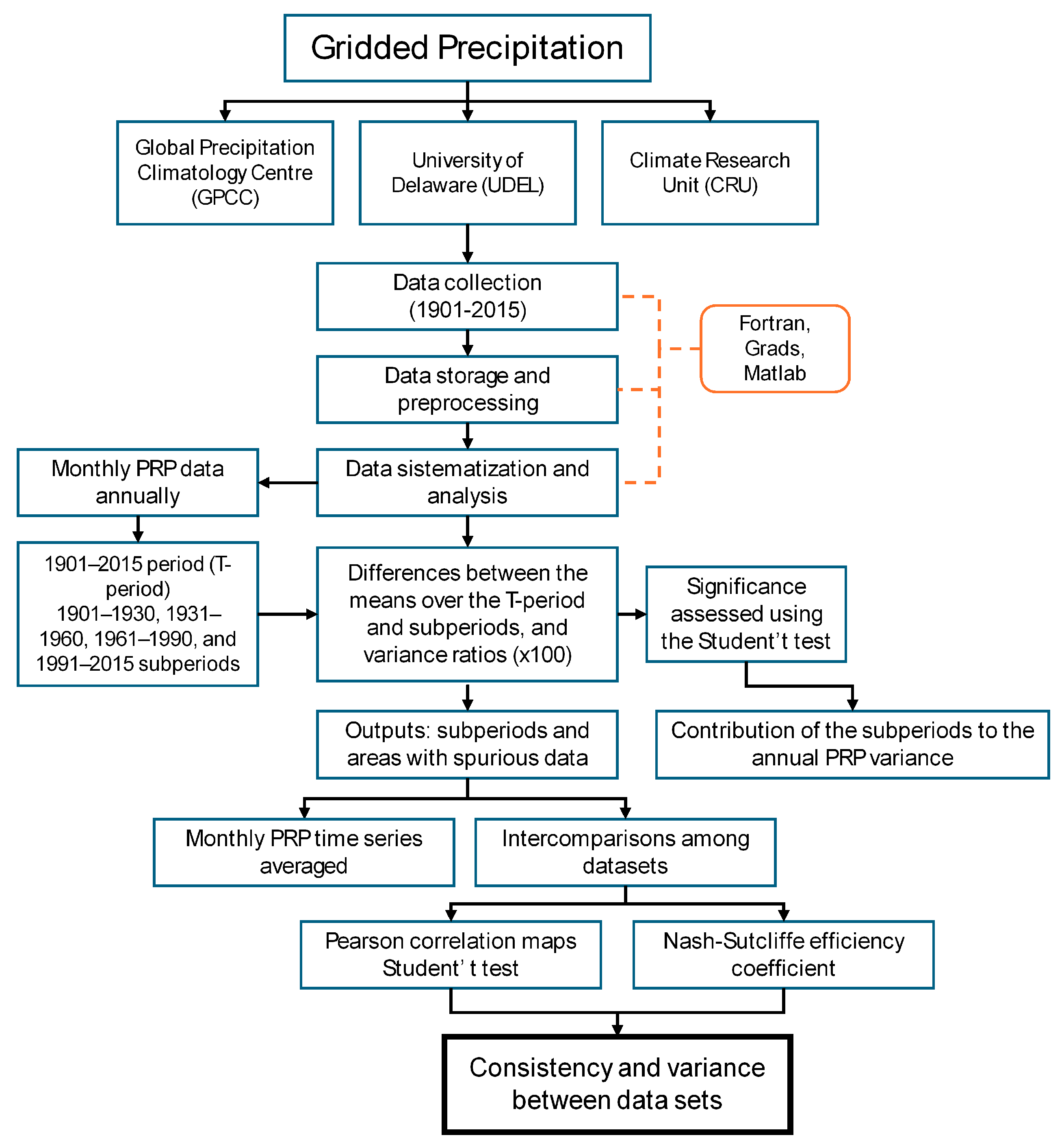

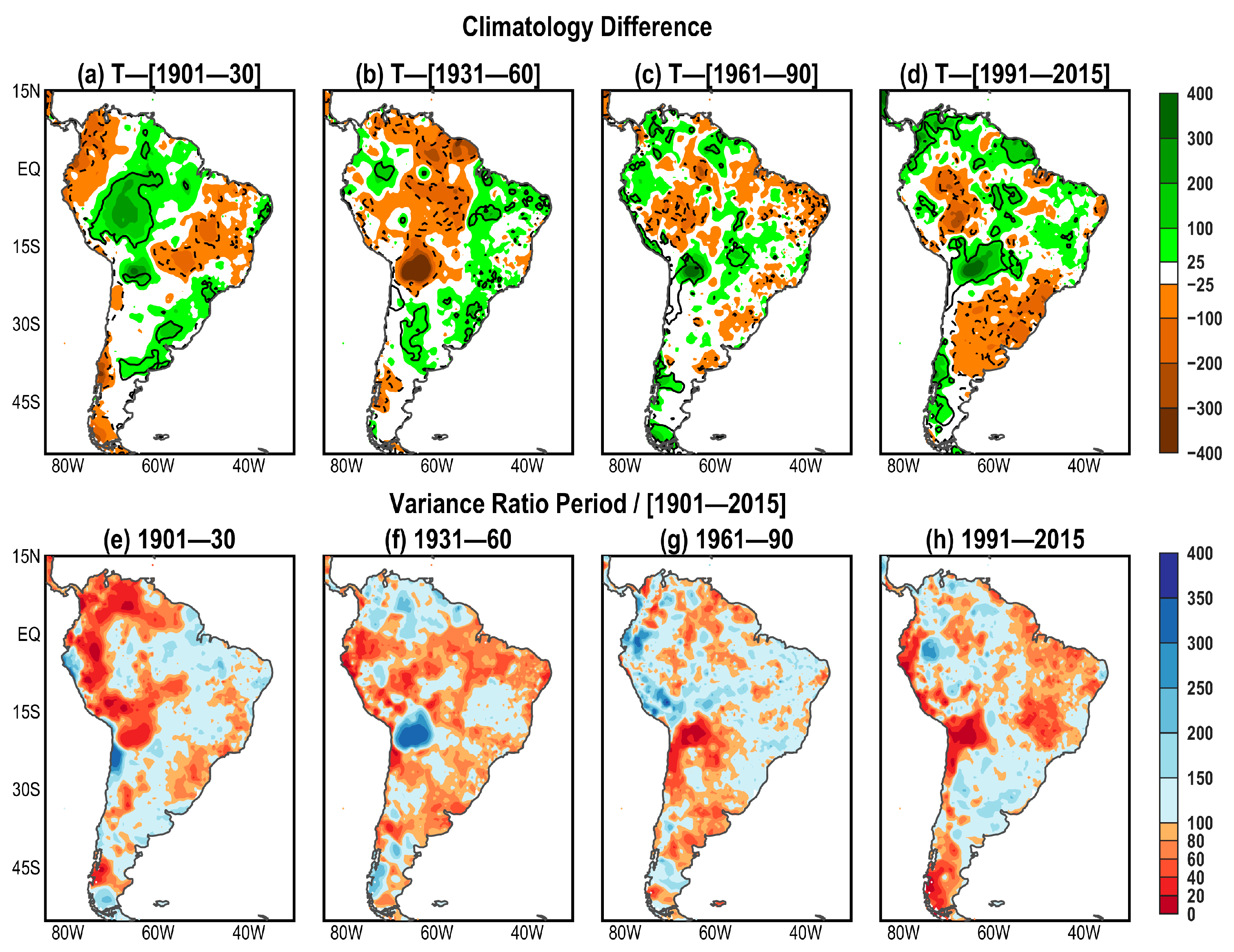
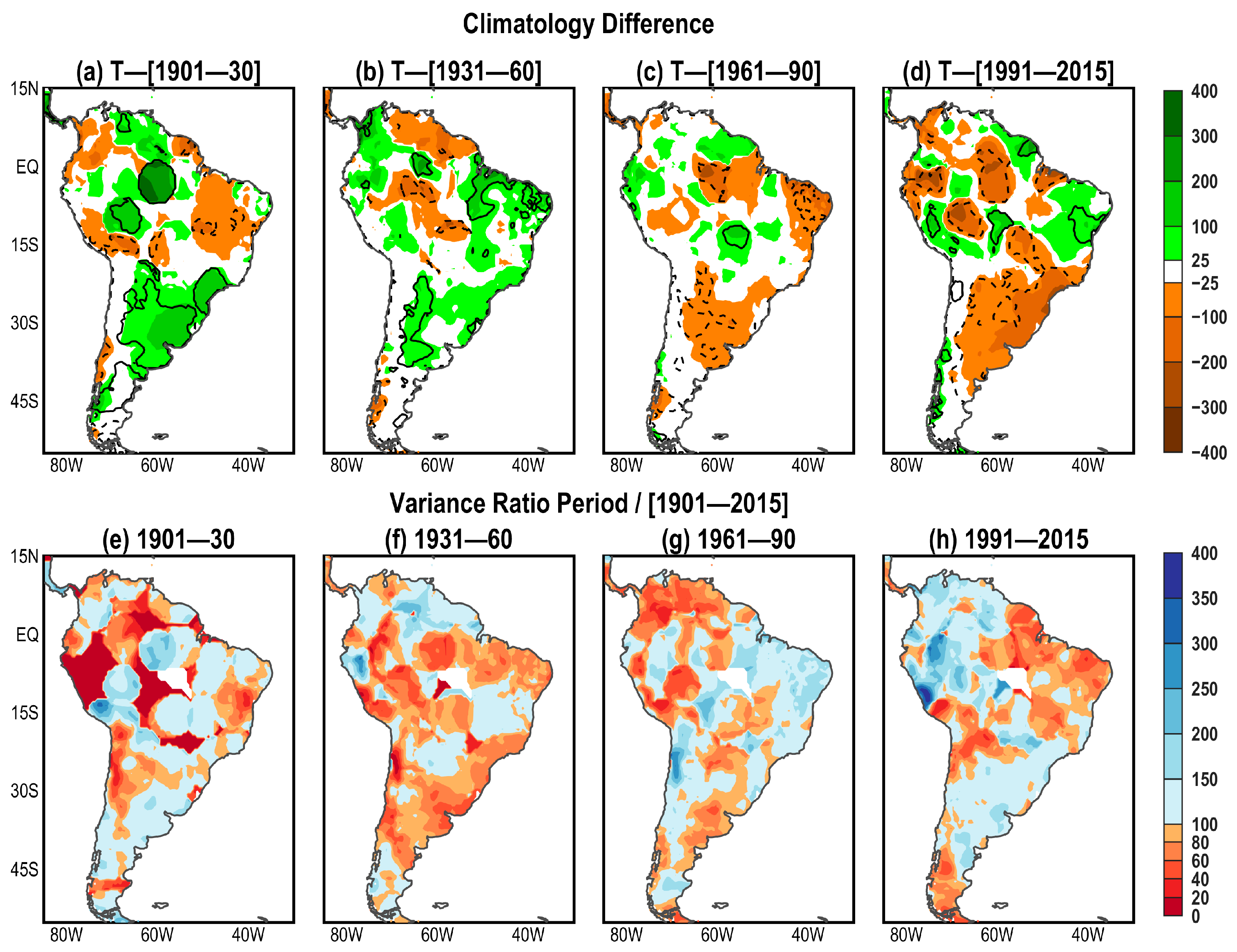
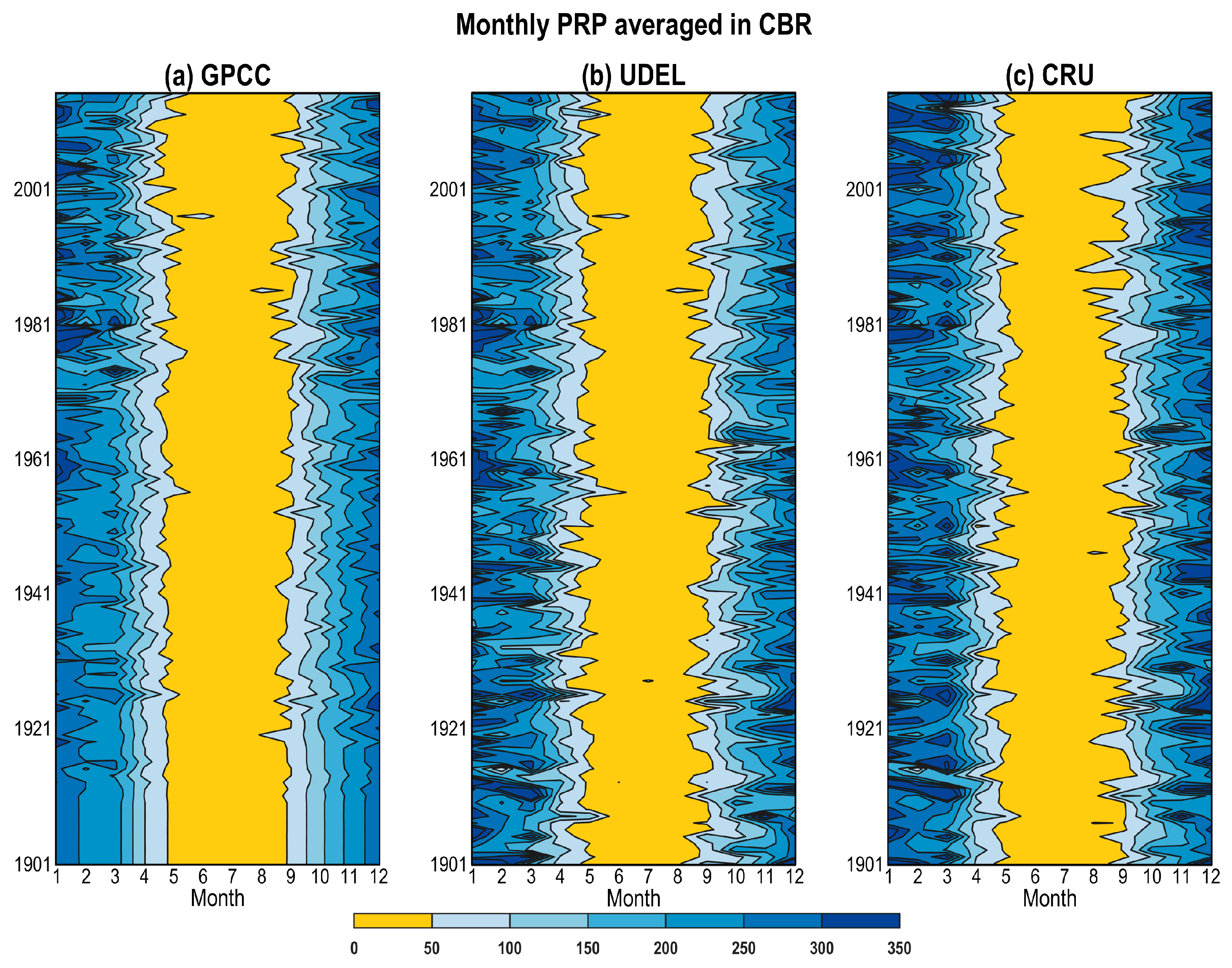


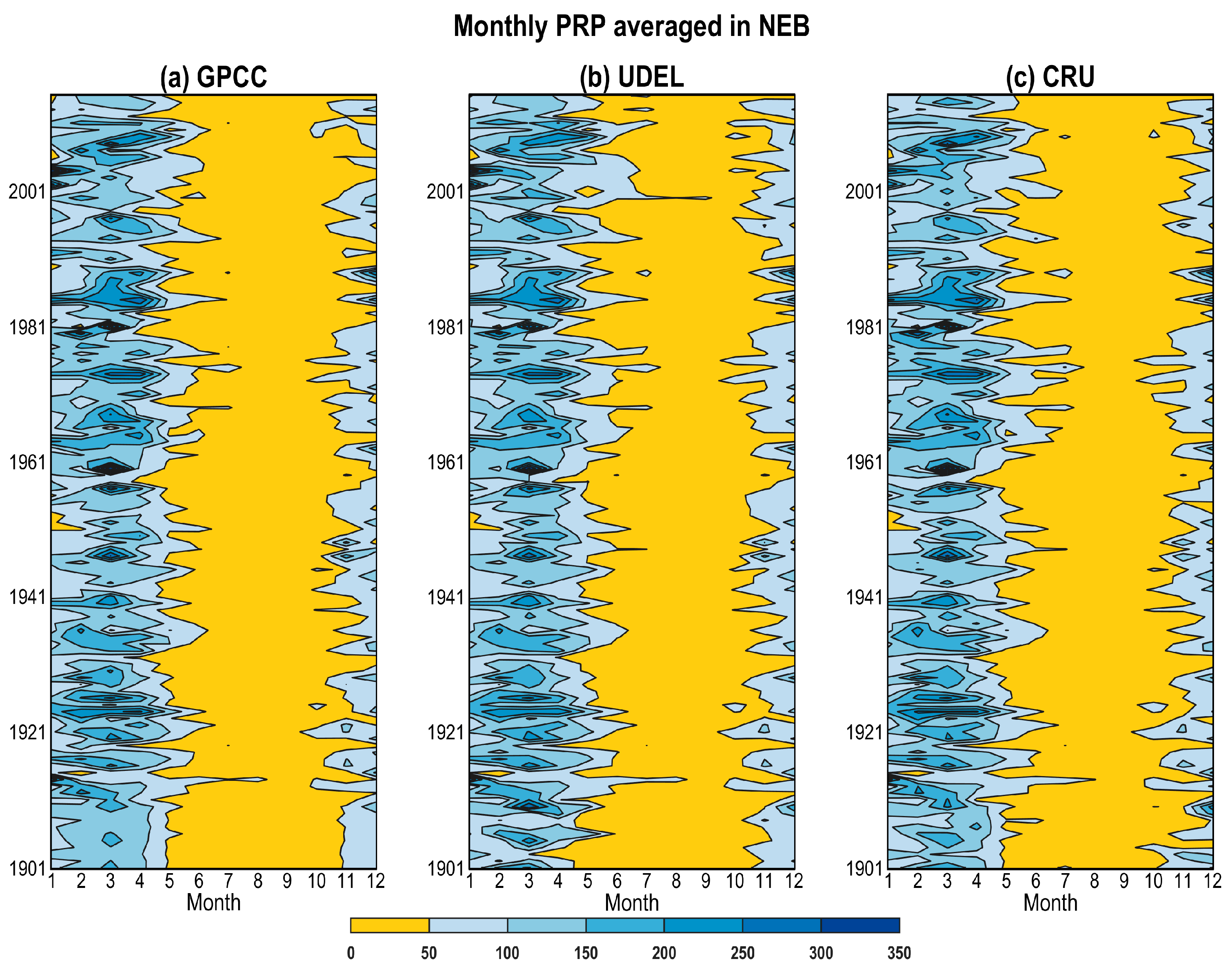
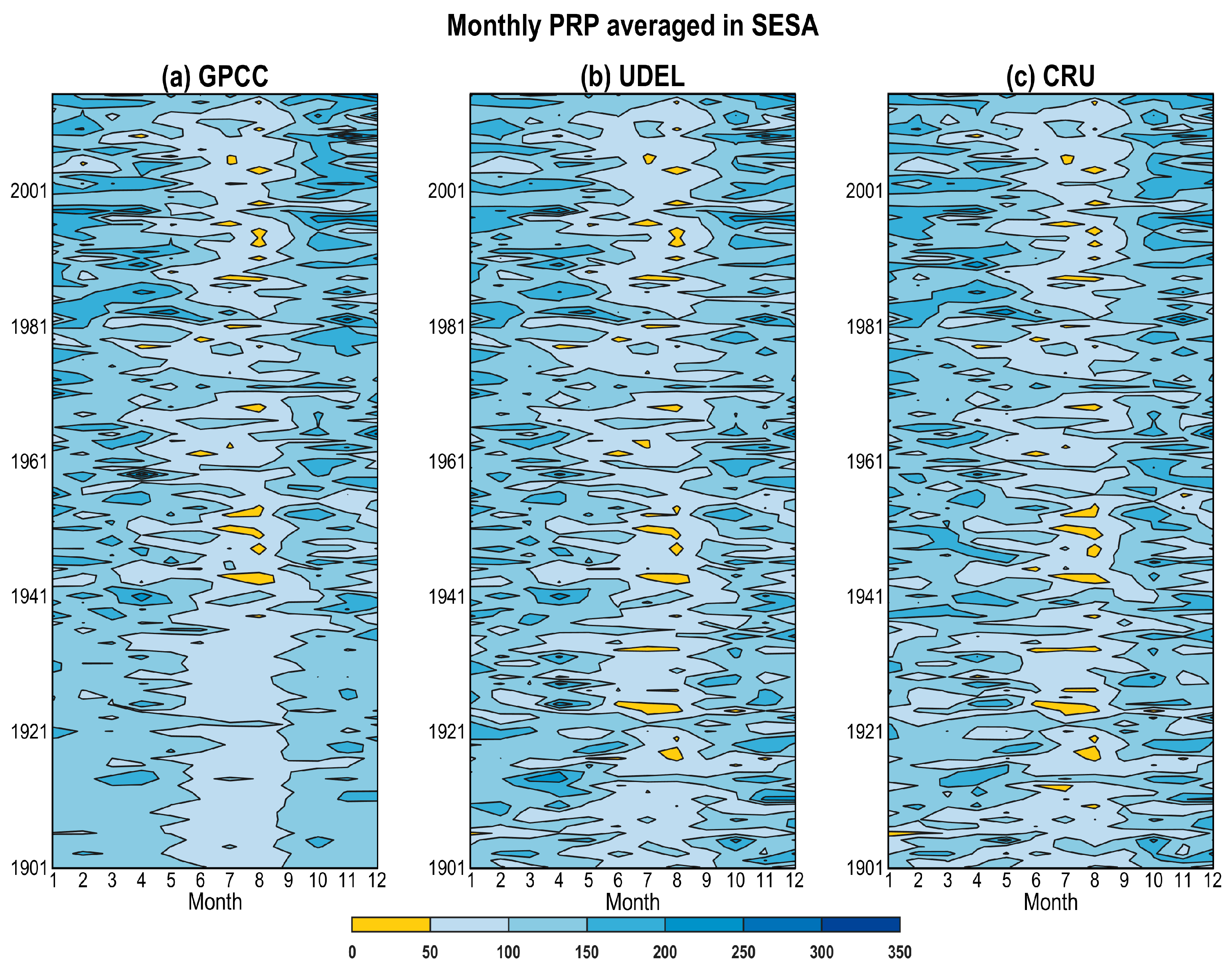

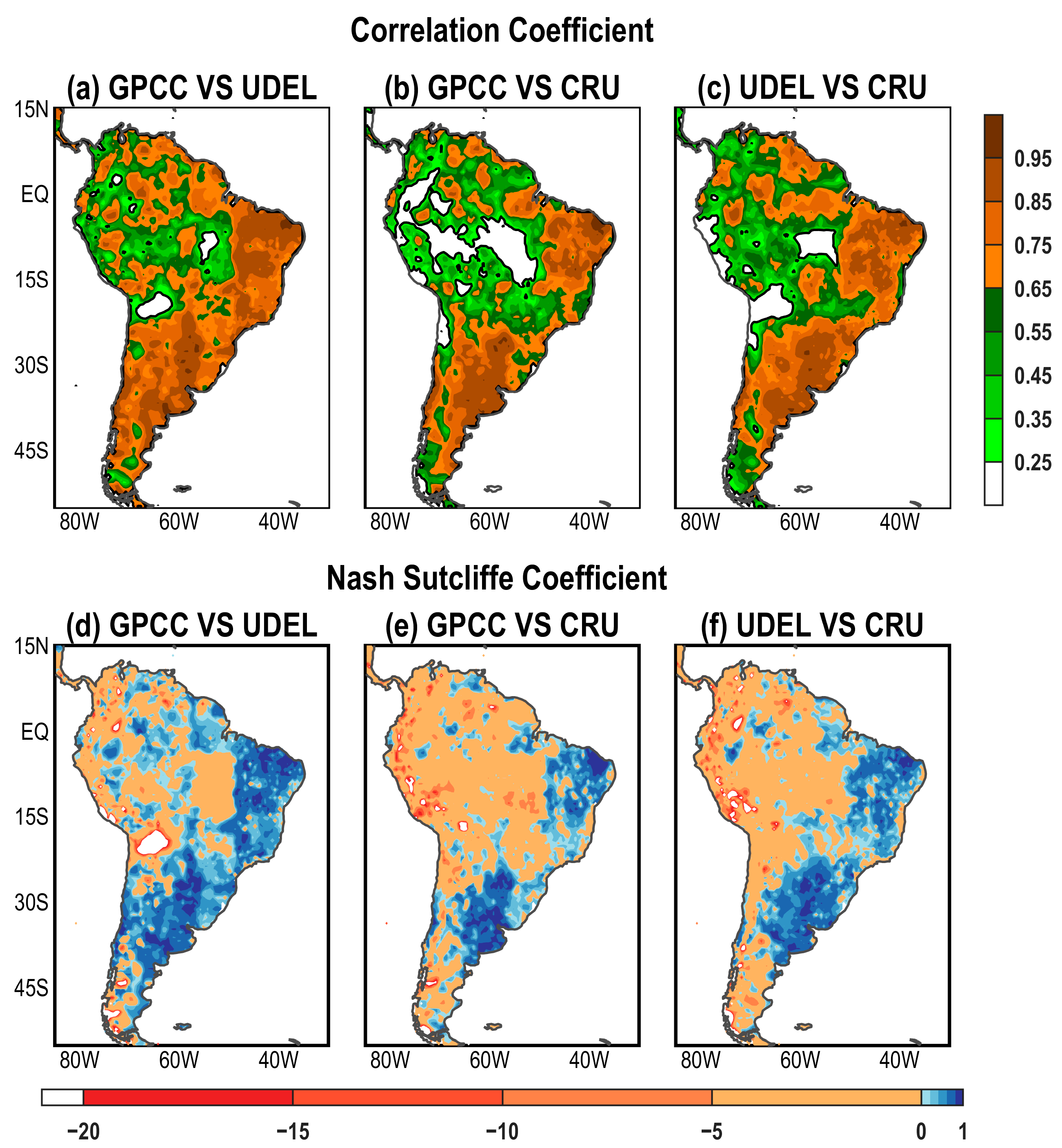
Disclaimer/Publisher’s Note: The statements, opinions and data contained in all publications are solely those of the individual author(s) and contributor(s) and not of MDPI and/or the editor(s). MDPI and/or the editor(s) disclaim responsibility for any injury to people or property resulting from any ideas, methods, instructions or products referred to in the content. |
© 2024 by the authors. Licensee MDPI, Basel, Switzerland. This article is an open access article distributed under the terms and conditions of the Creative Commons Attribution (CC BY) license (https://creativecommons.org/licenses/by/4.0/).
Share and Cite
Kayano, M.T.; Cerón, W.L.; Andreoli, R.V.; Souza, R.A.F.; Shimizu, M.H.; Jimenez, L.C.M.; Souza, I.P. Intercomparisons of Three Gauge-Based Precipitation Datasets over South America during the 1901–2015 Period. Meteorology 2024, 3, 191-211. https://doi.org/10.3390/meteorology3020009
Kayano MT, Cerón WL, Andreoli RV, Souza RAF, Shimizu MH, Jimenez LCM, Souza IP. Intercomparisons of Three Gauge-Based Precipitation Datasets over South America during the 1901–2015 Period. Meteorology. 2024; 3(2):191-211. https://doi.org/10.3390/meteorology3020009
Chicago/Turabian StyleKayano, Mary T., Wilmar L. Cerón, Rita V. Andreoli, Rodrigo A. F. Souza, Marília H. Shimizu, Leonardo C. M. Jimenez, and Itamara P. Souza. 2024. "Intercomparisons of Three Gauge-Based Precipitation Datasets over South America during the 1901–2015 Period" Meteorology 3, no. 2: 191-211. https://doi.org/10.3390/meteorology3020009
APA StyleKayano, M. T., Cerón, W. L., Andreoli, R. V., Souza, R. A. F., Shimizu, M. H., Jimenez, L. C. M., & Souza, I. P. (2024). Intercomparisons of Three Gauge-Based Precipitation Datasets over South America during the 1901–2015 Period. Meteorology, 3(2), 191-211. https://doi.org/10.3390/meteorology3020009







